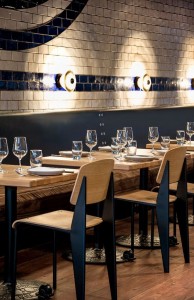[The Interpersonal dynamics of Communication are always interesting, and never more so than when we are pushed into close proximity with others. Cramped conditions can be ad-hoc laboratories: chances to see how individuals cope with another’s intrusion into their intimate space.This piece from 2014 is a ‘close reading’ of these kinds of encounters, with an important lesson that usually follows]
Life has a way of randomly throwing us together with complete strangers in tight spaces. Trains, elevators and planes typically violate the two- to four-foot zone that the study of proxemics says Americans want to preserve for themselves. How do we cope?
We’ll skip sitting in steerage on an airliner, where the experience is something to be endured, and where travelers are thankful to still have free use of the pressurized air. But consider the ubiquitous elevator, and the mix-and-match experience of sharing a meal in a railroad dining car.
As little closets expected to hold 10 or 12 people, elevators represent the triumph of necessity over comfort. Walking up twelve flights of stairs is a good workout. But no one wants to arrive at their business destination looking like they just finished the New York Marathon. So in the cramped space of the little vertical room eyes are averted to the ceiling, the poster advertising the restaurant in the lobby, or to a middle distance that is supposed to relieve others of the need to respond. It actually becomes harder to remain completely disengaged when only one or two are on an elevator. But there are safe tropes for a brief conversation that can help pass the time. Comments on the weather are usually safe, as are observations on how slow this particular version of the vertical room is. In a hotel, perhaps a timid query about where a co-passenger is from will work. But even that can tread near the borders of the acceptable. Not surprisingly, our comfort in these settings seems to be in direct proportion to the frequency of the experience. Living in the center of Chicago or New York, a person learns how to be a compatible stranger.
As the elevator went up the mood of the passengers inevitably went down.
A few years ago I was at a convention at a large urban hotel where the management thought it would be a good idea to include a small built-in television just above the elevator’s control panel. Strangers who stepped in had to be ready for more than a vertical ride. They were immediately thrust into the world of CNN, where a good day means covering a national or world crisis with live and often disturbing images of mayhem. On this occasion I recall a report focusing on community outrage over a police shooting. The story featured a home video of police beating and subduing two African American men. Gunshots followed and one of the men died.
Endlessly looping the footage of the attacks over audio discussions of excessive force had the effect of throwing many convention-goers out of their celebratory mood and into the much harder world of a socially polarized nation. As the elevator went up the mood of the passengers inevitably went down.
Here’s the interesting thing. The collection of individuals in the elevator became common witnesses to an ugly incident. And yet no one wanted to react; no one wanted to reveal themselves to strangers by overtly reacting to the report. Opinions remained too intimate to risk with this transitional group. Even so, our daily lives are not unlike this transitional moment. Like the tiny space that shuttles between floors, the pervasiveness of our media constantly deliver us to social situations which are not stable for very long. Media relentlessly push us into vastly different crises that are part of the human drama: some comforting and most disturbing.
Eating in an Amtrak dining car is as close as most of us will get to making contact with a random group of ordinary Americans.
Long-distance rail travel is another interesting case. The day of the long-distance passenger train has mostly passed in the United States. Even so, some travelers and a handful of trains remain. By custom, a single passenger eating in the dining car of a train will be asked to join others to make a table of four. Amtrak doesn’t accommodate the shy who want to eat alone. Perhaps no other social routine is so likely to throw a person into the intimacy of a shared meal with total strangers. And yet the experience can be surprisingly refreshing.
If most of us live in a bubble of like-minded friends, the dining car is easily going to pierce it. On a recent trip that included lunch and diner I met a clearly well-heeled woman from Virginia horse country returning home after a speech to a woman’s group. We sat across from a trucker from Elkhart Indiana who delivers buses all over the U.S. (and had to tell us about his $60,000-a-year salary). At other meals I met two retired professors from Berkeley on their way to see family members in Minnesota, a grizzled Florida retiree returning from a football game in Nebraska, and a perfectly dressed older woman off to see friends in the District of Columbia.
The rules of the table were always clear: references to hometowns, the lateness of the train, and dispersed families are all fair game. Politics, religion and other “third rail” topics are not. We also had the common experience of having hit a car just after midnight. It had died and been hastily abandoned on the tracks. So we compared notes on who had been able to sleep while fire crews pulled the impaled automobile off the front of the engine.
My experience is that Midwesterners sometimes go on for too long about the prospects of their city or college football teams. I usually return the favor by becoming loquacious about the surprising beauty of New Jersey. But there is a bigger lesson here. Spending time in these close quarters is usually reassuring. If we allow it, even this chance encounter can remind us of our shared and simple decency.
![]()


